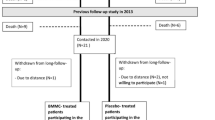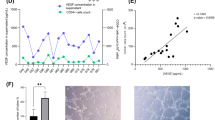Abstract
Early reperfusion of occluded coronary arteries has significantly reduced early mortality and improved the long-term prognosis of patients with an acute myocardial infarction. However, the development of postinfarction heart failure remains a major challenge. Initial experimental studies indicated that mononuclear progenitor cells derived from the bone marrow may contribute to the functional regeneration of freshly infarcted myocardium and increase neovascularization of ischemic areas. A number of clinical pilot trials have now transferred the experimental approach into the clinical arena, aiming at regenerating myocardial function with infusion of bone-marrow-derived progenitor cells in patients after an acute myocardial infarction. While these initial trials using intracoronary infusion of bone-marrow-derived progenitor cells indeed suggested that such a strategy appears to be feasible and safe in patients with an acute myocardial infarction, there is definitely a pressing need for a proof-of-concept study documenting a potentially beneficial effect of progenitor cell therapy on cardiac function.
This is a preview of subscription content, access via your institution
Access options
Subscribe to this journal
Receive 12 print issues and online access
$209.00 per year
only $17.42 per issue
Buy this article
- Purchase on Springer Link
- Instant access to full article PDF
Prices may be subject to local taxes which are calculated during checkout

Similar content being viewed by others
References
Orlic D et al. (2001) Bone marrow cells regenerate infarcted myocardium. Nature 410: 701–705
Kocher AA et al. (2001) Neovascularization of ischemic myocardium by human bone-marrow-derived angioblasts prevents cardiomyocyte apoptosis, reduces remodeling and improves cardiac function. Nat Med 7: 430–436
Strauer BE et al. (2002) Repair of infarcted myocardium by autologous intracoronary mononuclear bone marrow cell transplantation in humans. Circulation 106: 1913–1918
Wollert KC et al. (2004) Intracoronary autologous bone-marrow cell transfer after myocardial infarction: the BOOST randomised controlled clinical trial. Lancet 364: 141–148
Fernández-Avilés F et al. (2004) Experimental and clinical regenerative capability of human bone marrow cells after myocardial infarction. Circ Res 95: 742–748
Schächinger V et al. (2004) Transplantation of progenitor cells and regeneration enhancement in acute myocardial infarction: final one-year results of the TOPCARE-AMI trial. J Am Coll Cardiol 44: 1690–1699
Montalescot G et al. (2001) Platelet glycoprotein IIb/IIIa inhibition with coronary stenting for acute myocardial infarction. N Engl J Med 344: 1895–1903
Stone GW et al. (2002) Comparison of angioplasty with stenting, with or without abciximab, in acute myocardial infarction. N Engl J Med 346: 957–966
Criteria Committee of the New York Heart Association (1994) Nomenclature and Criteria for Diagnosis of Diseases of the Heart and Great Vessels, edn 9, 253–256. Boston: Little, Brown
Dodge HT et al. (1960) The use of biplane angiography for the measurement of left ventricular volume in man. Eur Heart J 60: 762–776
Sheehan FH et al. (1986) Advantages and applications of the centerline method for characterizing regional ventricular function. Circulation 74: 293–305
Assmus B et al. (2002) Transplantation of Progenitor Cells and Regeneration Enhancement in Acute Myocardial Infarction (TOPCARE-AMI). Circulation 106: 3009–3017
Anon (1985) The Thrombolysis in Myocardial Infarction (TIMI) trial. Phase I findings. TIMI Study Group. N Engl J Med 312: 932–936
Acknowledgements
The Clinical Studies Coordinating Center (CSCC) of the Department of Cardiology, Johann Wolfgang Goethe University, Frankfurt, supported trial logistics. The Institute for Transfusion Medicine financed production and transportation of bone marrow aspirate and trial medication. The following nonprofit research organizations supported preliminary research: Alfried Krupp Stiftung, the German Research Foundation, and the European Vascular Genomics Network. Guidant provided balloon catheters, and an unrestricted research grant. Lilly provided abciximab.
Author information
Authors and Affiliations
Corresponding author
Ethics declarations
Competing interests
The authors declare no competing financial interests.
Rights and permissions
About this article
Cite this article
Schächinger, V., Tonn, T., Dimmeler, S. et al. Bone-marrow-derived progenitor cell therapy in need of proof of concept: design of the REPAIR-AMI trial. Nat Rev Cardiol 3 (Suppl 1), S23–S28 (2006). https://doi.org/10.1038/ncpcardio0441
Received:
Accepted:
Issue Date:
DOI: https://doi.org/10.1038/ncpcardio0441
This article is cited by
-
Bone marrow-derived cells for cardiovascular cell therapy: an optimized GMP method based on low-density gradient improves cell purity and function
Journal of Translational Medicine (2014)
-
Effects on Arrhythmogenesis and Arrhythmic Threshold of Injection of Autologous Fibroblasts into Myocardial Infarcts in Adult Pigs
Journal of Cardiovascular Translational Research (2012)
-
Stem-cell-based therapy and lessons from the heart
Nature (2008)



